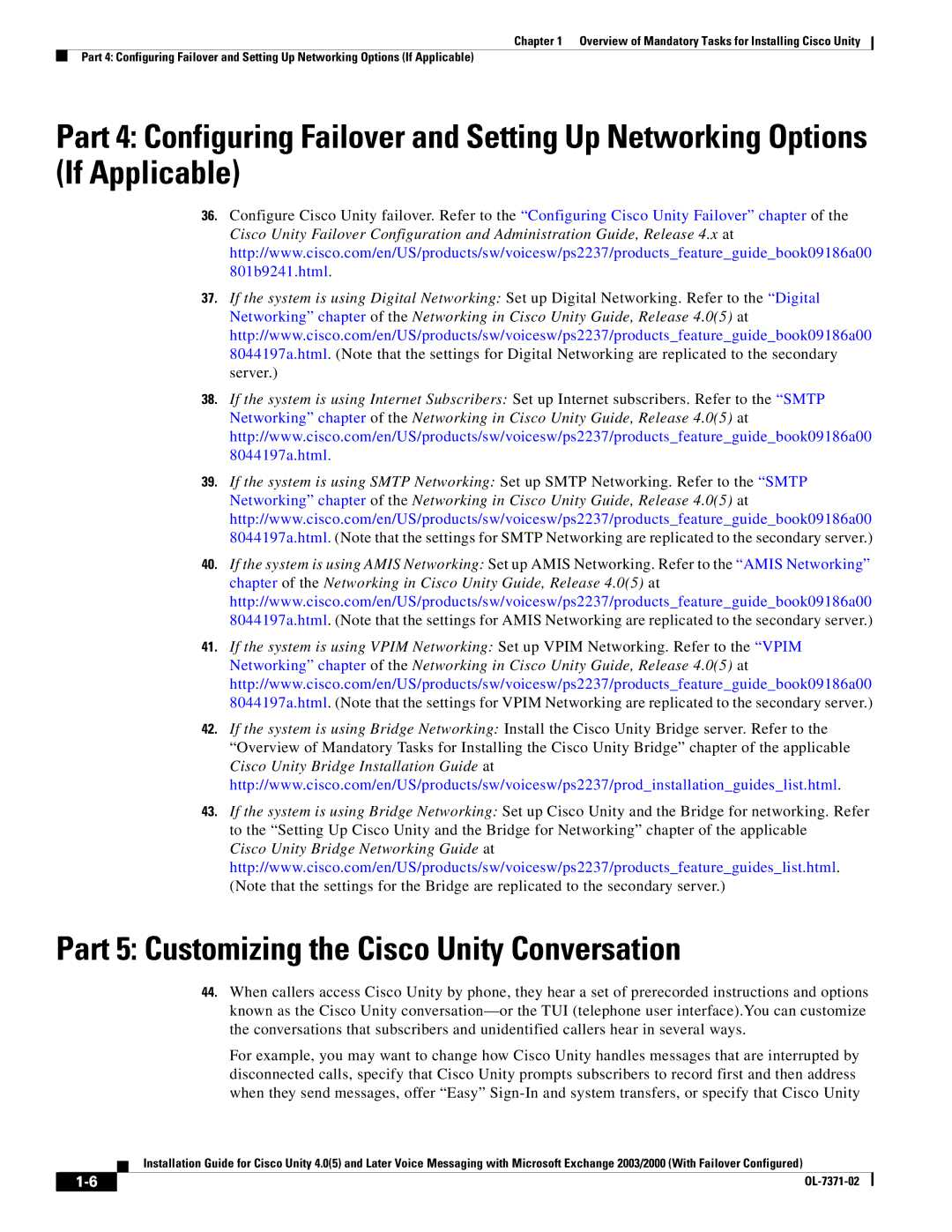
Chapter 1 Overview of Mandatory Tasks for Installing Cisco Unity
Part 4: Configuring Failover and Setting Up Networking Options (If Applicable)
Part 4: Configuring Failover and Setting Up Networking Options (If Applicable)
36.Configure Cisco Unity failover. Refer to the “Configuring Cisco Unity Failover” chapter of the Cisco Unity Failover Configuration and Administration Guide, Release 4.x at http://www.cisco.com/en/US/products/sw/voicesw/ps2237/products_feature_guide_book09186a00 801b9241.html.
37.If the system is using Digital Networking: Set up Digital Networking. Refer to the “Digital Networking” chapter of the Networking in Cisco Unity Guide, Release 4.0(5) at http://www.cisco.com/en/US/products/sw/voicesw/ps2237/products_feature_guide_book09186a00 8044197a.html. (Note that the settings for Digital Networking are replicated to the secondary server.)
38.If the system is using Internet Subscribers: Set up Internet subscribers. Refer to the “SMTP Networking” chapter of the Networking in Cisco Unity Guide, Release 4.0(5) at http://www.cisco.com/en/US/products/sw/voicesw/ps2237/products_feature_guide_book09186a00 8044197a.html.
39.If the system is using SMTP Networking: Set up SMTP Networking. Refer to the “SMTP Networking” chapter of the Networking in Cisco Unity Guide, Release 4.0(5) at http://www.cisco.com/en/US/products/sw/voicesw/ps2237/products_feature_guide_book09186a00 8044197a.html. (Note that the settings for SMTP Networking are replicated to the secondary server.)
40.If the system is using AMIS Networking: Set up AMIS Networking. Refer to the “AMIS Networking” chapter of the Networking in Cisco Unity Guide, Release 4.0(5) at http://www.cisco.com/en/US/products/sw/voicesw/ps2237/products_feature_guide_book09186a00 8044197a.html. (Note that the settings for AMIS Networking are replicated to the secondary server.)
41.If the system is using VPIM Networking: Set up VPIM Networking. Refer to the “VPIM Networking” chapter of the Networking in Cisco Unity Guide, Release 4.0(5) at http://www.cisco.com/en/US/products/sw/voicesw/ps2237/products_feature_guide_book09186a00 8044197a.html. (Note that the settings for VPIM Networking are replicated to the secondary server.)
42.If the system is using Bridge Networking: Install the Cisco Unity Bridge server. Refer to the “Overview of Mandatory Tasks for Installing the Cisco Unity Bridge” chapter of the applicable Cisco Unity Bridge Installation Guide at http://www.cisco.com/en/US/products/sw/voicesw/ps2237/prod_installation_guides_list.html.
43.If the system is using Bridge Networking: Set up Cisco Unity and the Bridge for networking. Refer to the “Setting Up Cisco Unity and the Bridge for Networking” chapter of the applicable
Cisco Unity Bridge Networking Guide at http://www.cisco.com/en/US/products/sw/voicesw/ps2237/products_feature_guides_list.html. (Note that the settings for the Bridge are replicated to the secondary server.)
Part 5: Customizing the Cisco Unity Conversation
44.When callers access Cisco Unity by phone, they hear a set of prerecorded instructions and options known as the Cisco Unity
For example, you may want to change how Cisco Unity handles messages that are interrupted by disconnected calls, specify that Cisco Unity prompts subscribers to record first and then address when they send messages, offer “Easy”
Installation Guide for Cisco Unity 4.0(5) and Later Voice Messaging with Microsoft Exchange 2003/2000 (With Failover Configured)
| ||
|
